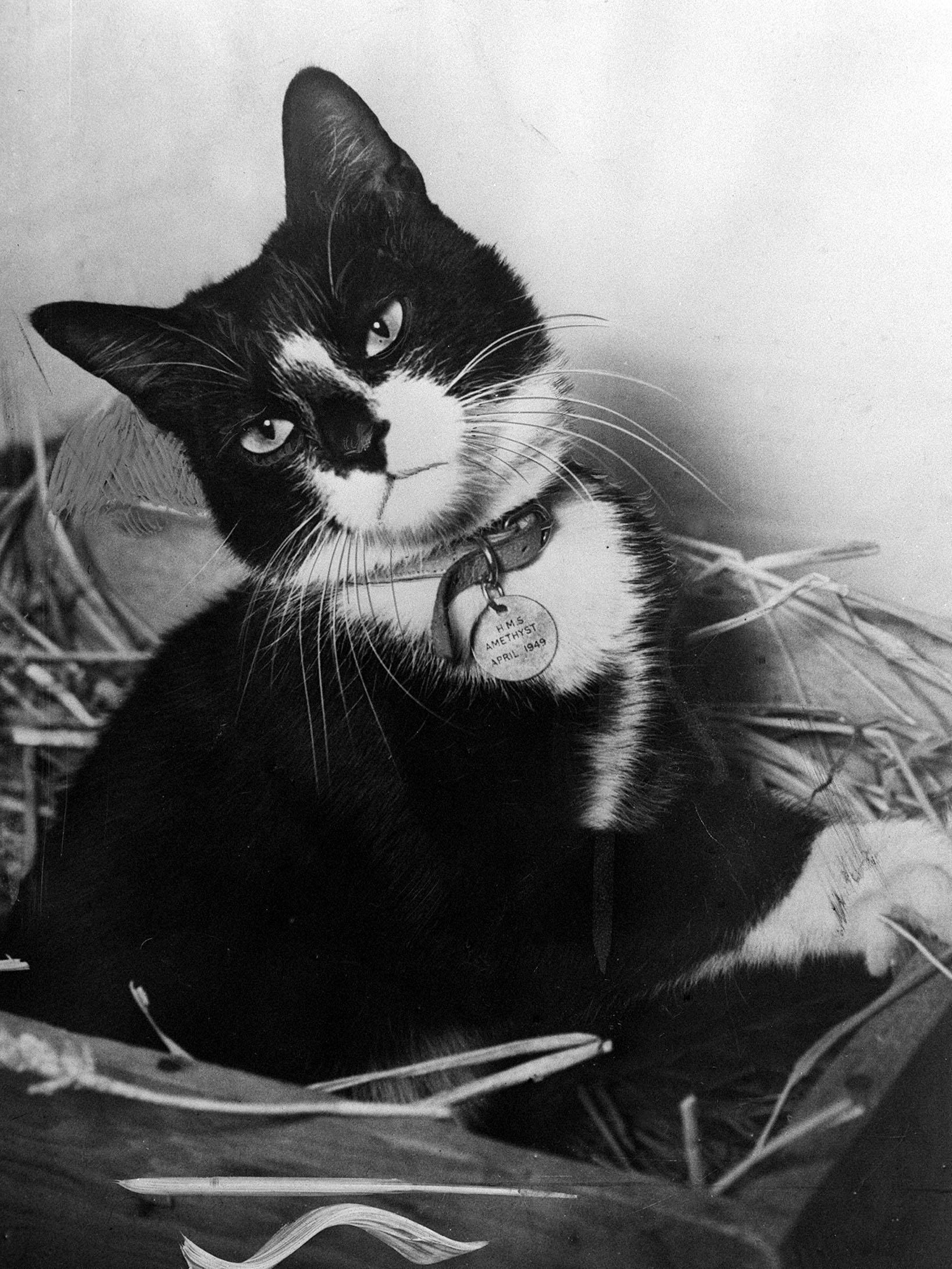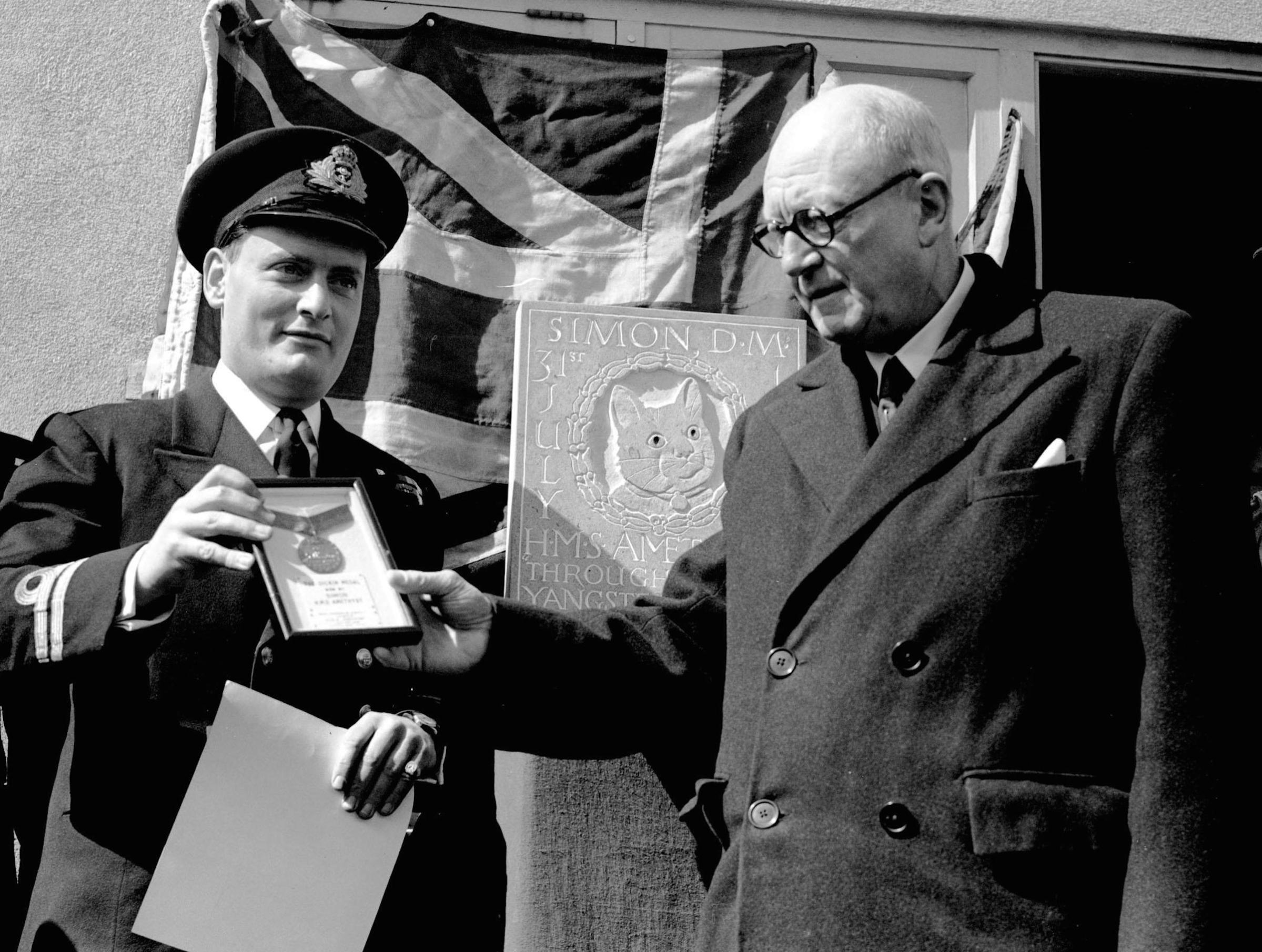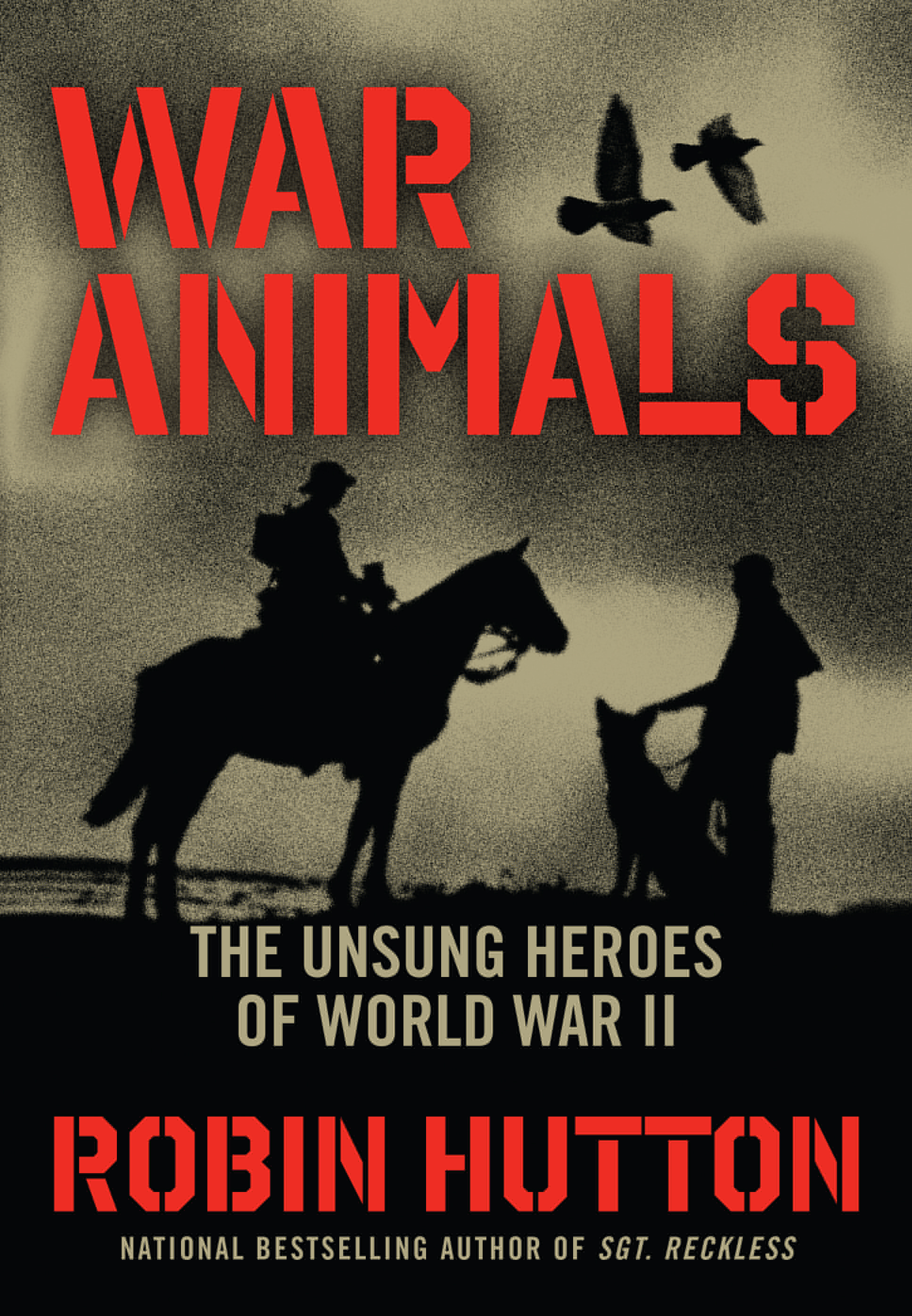
Cats have been clawing their way into wartime history for a long time. Take for example Crimean Tom, sometimes called Sevastopol Tom. In a Russian port town in 1854, he saved invading French and British troops from starvation by leading them to a secret cache of food.
Then there was Tiddles, who served several Royal Navy ships in World War II, along the way logging more than 30,000 miles.
During the London blitz in 1940, Faith the Church Cat seemed almost psychic in how she saved her newborn kitten from a German air raid that destroyed their home, St. Augustine’s Church.
And as recently as 2004 in Iraq, Private First Class Hammer ingratiated himself to a U.S. Army unit and eradicated the mice that were contaminating their food supplies.
But none of those cats could boast of having a Dickin Medal, the highest British honor awarded for animal displays of bravery in battle. As of 2018, only one cat has ever earned the prestigious prize.
His name was simple: Simon.
Simon was discovered in March 1948 poking around the docks of Stonecutters Island in Hong Kong. Thought to be about a year old, the scrawny black and white tomcat was scrounging for food when a British sailor spotted him. Seventeen-year-old Ordinary Seaman George Hickinbottom decided a cat was just what the ship needed to get rid of its rats. The rodent infestation posed risks to onboard foodstuffs—and to the crew’s overall health. So George tucked Simon inside his jacket, smuggled him aboard the Amethyst, and hid the tomcat in his cabin.
In April 1949, the Amethyst was ordered to sail up the Yangtze River from Shanghai to Nanking, then relieve the HMS Consort of her duties. China was in the midst of a bloody civil war between the communist insurgents of Mao Tse Tung’s People’s Liberation Army (PLA) and the ruling nationalist (or Kuomintang) Party of Chiang Kai-shek, and the Consort was long overdue for relief, having guarded the British Embassy for some time in case Mao’s army took the city and forced an embassy evacuation.
A cease-fire agreement between the two sides was due to expire at midnight on April 21, with the communists demanding that the nationalists agree to their terms or else fighting would resume. Mao’s PLA held the Yangtze’s north side and the nationalists controlled the south bank.
Because Britain had not taken a side in the Chinese conflict, no trouble was expected, and British officials believed the Amethyst could reach Nanking before the cease-fire ended. But, on the morning of April 20, the Amethyst was still about 60 miles from the city when communist fire resumed from the north shore. Explosions rocked the ship, with the bridge, wheelhouse and low power room hit first. In all, the ship sustained more than 50 hits. Nineteen men, including its captain, were killed in the April 20 attack; 27 more were wounded. Eventually, the Amethyst took shelter in a creek a little way upstream. Negotiations with the communists soon began for the release of the stricken, cornered Amethyst and its crew.
Where was Simon during the chaos and carnage? No one knows for sure, but when the shelling began, he likely was in the captain’s cabin curled up in his cap. A Chinese shell blasted a huge hole in the nearby bulkhead, and four shards of shrapnel hit the defenseless cat in the back and legs as he bolted or was thrown by the force of the explosion. Simon’s face was also burned, and his whiskers and eyebrows singed. The stunned cat apparently crawled into a corner, out of the way, and passed out.
Simon was missing for several days before he staggered on deck and was discovered by Petty Officer George Griffiths, who gingerly picked the cat up and took him to sick bay.
The Amethyst mascot was in very bad shape—severely weak, dehydrated, and in pain from his injuries. Medical officer Michael Fearnley went to work. He removed the shrapnel in four places and stitched Simon up before tending to his burned face. There was concern that the cat’s hearing might have been damaged by being so close to the deafening blast. Besides all that, Simon’s heart was also weak. Fearnley gave Simon only a fair chance of survival at best.
Dr. Fearnley suggested that Simon hang out in sick bay to help shore up morale among the remaining young crewmen, many traumatized by the attack, the loss of their crewmates, and the grief of having to witness twenty burials at sea. Because Simon had also endured the horrific attack and its aftermath, he was considered one of them.
Even so, conditions aboard the Amethyst began to seriously deteriorate. Because of dwindling food and water supplies, rations were cut in half. Nearly three months after the original attack, negotiations were deadlocked, at least in part on account of the communists’ demand that the Amethyst’s men admit they had wrongly invaded national Chinese waters and fired first on Mao’s army.
Between the standoff in talks and the ship’s dangerously low fuel supplies, the Captain was increasingly fearful. And his solution was old-fashioned and simple: make a run for it.
On the moonless night of July 30, with the merchant vessel Kiang Ling Liberation passing the HMS Amethyst and heading down river around 10:00, he seized the moment and dared to attempt a 104-mile run to the open sea under cover of darkness.
The enemy’s response from shore was less aggressive than expected; luck certainly seemed to be with the crew of the Amethyst that hot summer night. Almost five hours later, the ship rendezvoused with the HMS Concord part way up the Huangpu River south of Wusong and was escorted the rest of the way. The captain sent a message: “Have rejoined the fleet south of Woo Sung. No damage or casualties. God save the King.”
After being held hostage for 101 days, the crew’s ordeal was over, and the Amethyst was cruising to Hong Kong.
News traveled fast as the Amethyst made its way to Hong Kong. Word of the ship’s exploits spread, and the entire crew were hailed as heroes—including Simon. The tomcat became an international celebrity overnight, thanks to heavy coverage by the press and movie newsreels. An army of cameras and reporters recorded the ship’s arrival in Hong Kong Harbor, and Simon posed for pictures with his shipmates during the celebration.
The captain replied to a request from the People’s Dispensary for Sick Animals, which awards the Dickin Medal, asking for confirmation of Simon’s heroic deeds. His testimonial letter reads, in part:
For many days Simon felt very sorry for himself, nor could he be located. His whiskers, even now, show signs of the explosion.
Rats, which began to breed rapidly in the damaged portions of the ship, presented a real menace to the health of the ship’s company, but Simon nobly rose to the occasion and after two months the rats were much diminished.
Throughout the incident Simon’s behaviour was of the highest order. One would not have expected a small cat to survive the blast from an explosion capable of making a hole over a foot in diameter in a steel plate.
Yet after a few days Simon was as friendly as ever. His presence on the ship, together with Peggy, the dog, was a decided factor in maintaining the high level of morale of the ship’s company.
On August 5, the Associated Press broke the news of the PDSA’s decision. One newspaper headline over the AP story told the tale: “Amethyst’s Cat Gets Dickin Medal for Catching Rats.” The PDSA’s decision had been unanimous.
Not only was Simon the only feline ever to receive a Dickin, he was also the only Royal Navy animal to earn the Dickin distinction.

All of this attention inspired fan mail for Simon—more than two hundred pieces a day—along with gift cans of food and cat toys. Lieutenant Stewart Hett, declared “cat officer,” was placed on a unique duty assignment: handling all of Simon’s mail and gifts.
On Nov. 11, 1949, Simon arrived home in England to another media frenzy, including LIFE magazine. He was placed in routine quarantine for six months, like other returning war animals, and the formal Dickin Medal presentation was set for December 11. Maria Dickin herself, along with the Lord Mayor of London, planned to attend. It was shaping up to be a grand and glorious affair.
But it was not meant to be. Two weeks before the presentation, Simon fell ill with a virus. He received treatment, including injections for a high fever and acute enteritis. But his war wounds had seriously weakened Simon’s heart.
Simon passed away on Nov. 28, having crammed a lot of living into his two short years. As one tribute put it, “the spirit of Simon slipped quietly away to sea.” Some said he died of a broken heart, that he missed his life aboard ship and the men he loved so much.
The crew were heartbroken. Cards and letters arrived at the quarantine shelter “by the truckload.” On its obituary page, TIME magazine featured Simon’s picture beneath a simple headline: “In Honored Memory.”

Adapted with permission from War Animals: The Unsung Heroes of World War II (Regnery Publishing) by Robin Hutton, national bestselling author of Sgt. Reckless: America’s War Horse. War Animals is available now at bookstores everywhere.
More Must-Reads from TIME
- How Donald Trump Won
- The Best Inventions of 2024
- Why Sleep Is the Key to Living Longer
- Robert Zemeckis Just Wants to Move You
- How to Break 8 Toxic Communication Habits
- Nicola Coughlan Bet on Herself—And Won
- Why Vinegar Is So Good for You
- Meet TIME's Newest Class of Next Generation Leaders
Contact us at letters@time.com